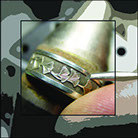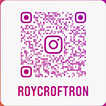

Processes


Hand Engraving
A traditional process where a graver is pushed into metal removing material. This process is ideal for objects where precision is crucial such as jewelry, watches, and firearms. Techniques such as bright cutting, sculpting, bulino (bank note engraving), and lettering are possible. Hand engraving should not be confused with "Drag and Drop" engraving where a diamond tip stylus is moved by machine, which is used on trophy plaques and the like.
Chasing
Chasing is the incising of lines, textures, and depressions in metal using a hammer and tools consisting of stamps and punches of various shapes. It differs from stamping in that the design is dependent on multiple strikes, and therefore could be viewed as a refinement of stamping. Unlike engraving, the design is pushed into the metal without any removal of metal required.
Repoussé
Repoussé employs similar tools and techniques as does chasing, but there are several differences. Chasing relies primarily on a compression of the metal (requiring a sturdy harder metal surface such as a steel plate to support the metal). Repoussé is often performed over a softer support such as pitch, lead, urethane, leather, or wood. Chasing is performed on the face side, but repoussé is performed on both sides or just the back. Blunt embossing tools are used to push and stretch the metal into positive and negative volumes. Liners are used to texture, enhance edges, and push metal, although care must be taken or the tool may cut through.
Patination
Patination is the altering of the metal surface by physical or chemical means. Most commonly patination of copper is done through a process of exposure to an oxidizing agent such as liver of sulfur. Ron is well versed in many patination processes, but prefers to oxidize copper to a dark brown with red, orange, or purple undertones. He has been known to also patinate copper to be dark green or verdigris green.
© Copyright 2022, Ronald VanOstrand

